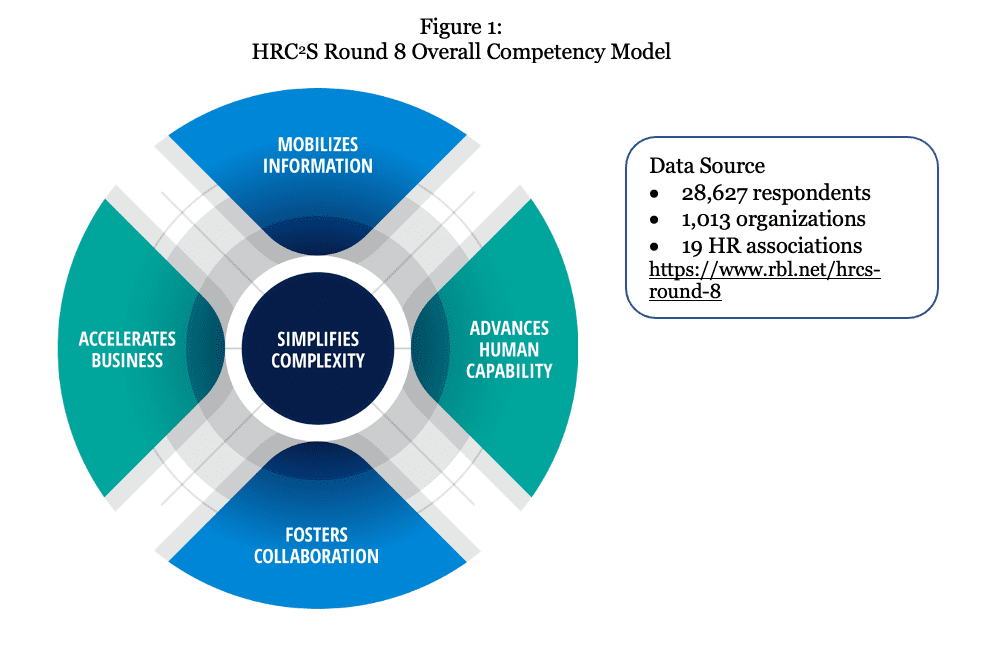

Dave Ulrich- Rensis Likert Professor of Business, Ross School of Business, University of Michigan
The COVID epidemic flared into a pandemic and now may be moving into an enduring endemic with lots of metaphors about how to face the future: reboot, reimagine, reinvent, remake, reset, revitalize, and so forth. Let me capture this future with renewal, with the prefix “re” meaning again and again building on the past and “new” meaning in innovative ways.
What should business and HR leaders expect from HR participation in renewal discussions?
In our research on HR Competencies & Capabilities Study (HRC2S) during the pandemic, we identified five competency domains (defined as verbs, not nouns) for HR to deliver value (figure 1), each of which suggests specific renewable actions.

1. Accelerates Business.
To accelerate business results, HR should be active in six dialogues paramount to today’s business success. Figure 2 lays out six current business conversations, and figure 3 is an audit to understand HR’s ability to contribute to those conversations.


Summary: HR should not focus their discussions on HR but on helping an organization succeed in the marketplace.
2. Advances Human Capability.
The “HR” field has come to mean anything to do with people in an organization, and it includes many terms, initiatives, and actions. We need to create a standardized framework so that investors can compare efforts across companies in the same way that GAAP accounting did to compare financial results in the 1930s. With such a framework, business and HR leaders can make better decisions about their people and organization investments.
We propose a human capability blueprint with four pathways to capture the array of “HR” initiatives (figure 4).

Using this human capability framework, current business agendas about investor confidence, technology innovation, government regulatory reporting, ESQ, competitive differentiators, or culture that arise (see figure 2) can be accomplished through integrated human capability solutions around talent, leadership, organization, and HR.
Summary: HR contributes insights on human capability (talent, leadership, organization, and HR practices) to deliver value.
3. Mobilizes Information.
Human capability work is both an art (creative ideas) and a science (evidence-based solutions). We have seen four stages of work on how HR can mobilize information to improve business outcomes (figure 5).

Historically, HR used information from scorecards and dashboards to benchmark how they were performing relative to others and then sought to gain insights from best-practice firms through predictive analytics that highlight why they are best practices. We have evolved this logic to “impact” where HR professionals access information to guide human capability investments. In the four human capability pathways (figure 3), we have identified 37 initiatives and been able to assess the extent to which they deliver employee, strategy, customer, investor, and social citizenship outcomes.
This summary grid in figure 6 reports preliminary research from the Organization Guidance System (OGS), with information from over 1,200 organizations and 3,000 respondents. The columns show the five stakeholders for any organization. The four pathways of human capability each have specific initiatives related to that pathway: talent 10, leadership 6, organization 12, and human resources 9. The colors in each cell represent high (green), medium (yellow), or low (white) relative impact of the specific initiative on the stakeholder outcome.

Summary: HR should provide information to guide and prioritize human capability investments to make sure that they deliver the greatest impact on stakeholder outcomes.
4. Fosters Collaboration.
In our research on creating an effective HR department, we found that a positive relationship within HR and between HR and all stakeholders (employees, leaders, customers, investors) had more impact on stakeholder outcomes than the design of the HR department (see the last row of figure 6). Collaboration begins within the HR department when HR professionals in various roles (specialists or generalists; administrative or strategic; technology or face-to-face; corporate or business) work well together. Based on studies in personal and marital relationships, we have identified six keys to an effective relationship that apply to HR (figure 7). In addition to HR relationships within HR, when HR engages with other business leaders in a team or other settings, they can and should be aware of ensuring positive relationships.

Summary: HR models positive relationships within HR and facilitates positive relationships within all business settings.
5. Simplifies Complexity.
Ultimately, HR turns aspirations into actions by turning complex options into simple solutions. HR models and embeds the discipline of simplicity by encouraging divergent thinking that explores options and then facilitating convergent thinking that focuses on solutions. By so doing, HR makes knowledge productive (figure 8).

Summary: HR helps create simple actions out of complex options and creates disciplines to make things happen.
Conclusion: The epidemic to pandemic to endemic challenges have placed HR at the center of business today. Our HRC2S and other research lead to five expectations from HR professionals.

………

Dave Ulrich is the Rensis Likert Professor at the Ross School of Business, University of Michigan, and a partner at The RBL Group, a consulting firm focused on helping organizations and leaders deliver value.
Written by: Dave Ulrich
Dave Ulrich Employee Experience Future of Work HR Strategy Leadership Strategy & Transformation
Previous post

- 1669
- 2
labelNews today2022.02.28.
HR For Ukraine – tools and resources to support workers and HR professionals
With the evolving war in Ukraine, our contributor, Sergio Caredda has created a site and started to collect resources, links, concrete actions that HR professionals might need or are actively doing in support [...]
Similar posts

labelArticles today2024.10.21.
The success-recipe to build agile and future-ready organizations in 2025 and beyond








Post comments (0)